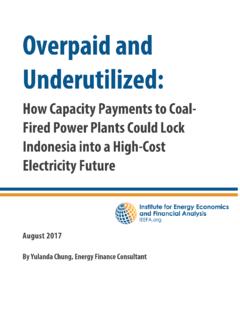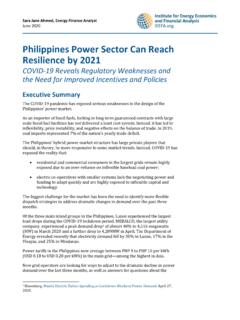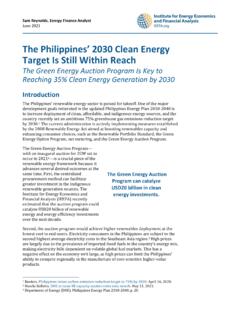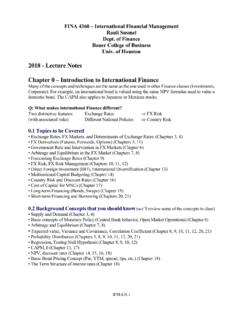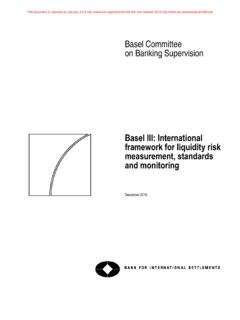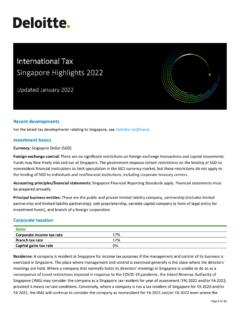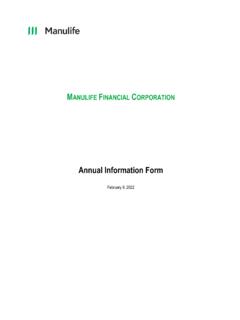Transcription of The Philippine Energy Transition - Institute for Energy ...
1 Sara Jane Ahmed, Energy Finance Analyst March 2019 1 The Philippine Energy Transition Building a Robust Power Market to Attract Investment, Reduce Prices, Improve Efficiency and Reliability The Business Case Philippine electricity prices are the highest in South East Asia at roughly US$ per kilowatt-hour (kWh) or Php 10 per kWh. Excessive reliance on imported coal and diesel is one of the main reasons the Philippines has the highest electricity prices in the Association of Southeast Asian Nations (ASEAN) region. The low uptake of renewables is surprising given that solar, wind, run-of-river hydro, geothermal and biogas are viable domestic generation options.
2 This is especially true when paired with storage for ancillary services such as frequency regulation providing both enhanced and firm frequency responses, spinning reserves and voltage support. These can be combined to create the type of cost effective and secure Energy system that an island nation like the Philippines needs. Corporates are making strides to divest from coal in favor of renewables. In 2018, Philippine companies, such as the Ayala Corporation subsidiary AC Energy , are set to sell US$1 billion worth of coal assets.
3 According to AC Energy , the sale aims to balance its renewable and thermal portfolios and raise capital to support regional expansion targeting 5 GW of geothermal, solar and wind projects in Vietnam, Indonesia, and the Philippines by 2025. AC Energy has invested in: an 81MW North Luzon wind farm in Pagudpud and a 52MW Northwind Power wind farm in Bangui Bay, as well as the MonteSol, IslaSol and SacaSol solar projects. AC Renewables has also invested in Vietnam's Nin Thuan, Khanh Hoa and Dak Lak solar parks, and in Indonesia's Sidrap wind farm and Salak and Darajat geothermal plants.
4 Ayala Corporation is not the only player to follow this global trend of fossil fuel divestment and renewable capacity investment. Companies in India, China, Malaysia, and most recently, Vietnam, are increasingly moving towards cancellations and delays involving new coal plants. And Ayala Corporation is not the only player to be following this trend in the Philippines. The Manila Electric Company, more popularly known as Meralco, shares this foresighted strategy and added a carve-out provision, better known as curtailment, to all their new coal power purchase agreements including the 1200MW Atimonan coal plant.
5 Meralco realizes it wants to protect ratepayers from the high risk of stranded assets by shifting the cost of bad decision-making to the coal power providers and their investors. Despite leadership from the more successful corporations in the power sector, others, including the San Miguel Corporation, are still locked into legacy strategies and are increasing their coal exposure. San Miguel is doing this through its power arm, SMC Global Power Holdings Corp., which planned to construct a 300-megawatt (MW) coal plant in Negros Occidental.
6 However, this is now cancelled because of leadership from the Governor of the Province of Negros Occidental who The Philippine Energy Transition 2 declared the area as coal-free and supportive of renewable This gives SMC Global Power the opportunity to instead build a renewable Energy portfolio to complement its current storage/batteries pipeline of 240MW for ancillary services to the grid in Although coal risk remains underpriced in South East Asia, there is increasing investor appetite in capital markets for renewable Energy projects.
7 Most recently, AC Energy issued the first ever US dollar climate bond in South East Asia valued at US$410 million on the singapore Stock Exchange to finance renewable Energy projects in the Asia-Pacific region including the Philippines, Vietnam, and Indonesia. AC Energy initially launched an offering of US$225 million for a 5-year tranche and closed at $300 million due to oversubscription. It also issued a US$110 million 10-year It is difficult to understand why, despite the systematic deflationary nature of renewable Energy prices globally and capital market support, emerging markets like the Philippines continue to lag behind global trends and are locking in long-term exposure to import coal, diesel and liquefied natural gas (LNG) import terminals.
8 According to the Department of Energy (DoE), between 2018 and 2019, the Philippines may expect 5,688 MW of new capacity at least 63% of which will be provided by coal-fired power If renewables are not lagging based on economics and financials, it is clear that they are losing due to a lack of transparency, cost incentives, and Power Purchase Agreements (PPAs), known in the Philippines as Power Supply Agreements (PSAs) that continue to protect fossil fuel interests. The Philippines faces a critical policy problem. Outdated market structures are compromising the country s ability to innovate and discouraging adoption of the cleaner and cheaper technologies that it badly needs.
9 The current market dysfunction is hindering rather than helping the Transition to more sustainable and affordable domestic solutions. The Philippines government can inject more diversity and more Energy security into the electricity system while helping lower costs to consumers by taking the following steps: Removing the Diesel Fuel Subsidy by the Department of Finance, Removing the Automatic Pass-Through by the Energy Regulatory Commission, Issuing Stranded Asset Risk Warnings across the financial value chain by the Central Bank of the Philippines and the Securities and Exchange Commission, and 1 Executive Order No.
10 19-02, Series of 2019. An Order Declaring the Province of Negros Occidental as a Source of Clean and Renewable Energy and a Coal-Free Province. 6 March 2019. 2 3 Renewables Now. UPDATE- AC Energy 's oversubscribed green bond sale hits USD 410m. February 5, 2019. 4 Republic of the Philippines Department of Energy . Coal-Fired Plants Are 63% of Projects in Pipeline. The Philippine Energy Transition 3 Overhauling procurement practices by introducing Least-Cost Mechanism auctions by the utilities and the Energy Regulatory Commission.
